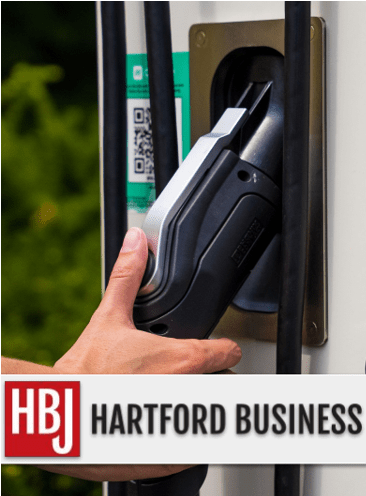
New funding and incentives folded into the just-passed, $1.2 trillion federal infrastructure bill and President Joe Biden’s Build Back Better legislation — still battling its way through Congress — could ignite a revolution in electric vehicle adoption in the U.S., according to local EV charger manufacturers who’ve had a front-row seat to seismic shifts in the industry over the last year.
“If we use that money wisely, what I foresee is that we’re going to have one of the biggest manufacturing booms this country’s seen in 100 years,” said Paul Vosper, president and CEO of Norwalk-based electric vehicle charger manufacturer and distributor JuiceBar. “It’s a once-in-a-lifetime opportunity.”
New federal investments such as those included in the infrastructure bill, which sets aside $7.5 billion nationally to build and deploy hundreds of thousands of EV chargers, dovetail with developments in the broader market, Vosper said, where consumers are warming to electric vehicles as technically superior and increasingly affordable products.
And those encouraging signs are having an immediate impact on Connecticut.
JuiceBar, which was originally founded in Hartford, plans to add around 100 new employees in 2022, mostly in manufacturing, Vosper said, and is moving its manufacturing operations from Oxford to a larger facility in Southbury.
“We produce about 100 chargers a week currently,” he said. “By next summer we’ll be able to produce 1,000 a week.”
For Vosper, the implications are wide-ranging. He sees federal spending on infrastructure and a resulting boom in EV technology as a pathway to well-paying jobs and a rejuvenated middle class.
“We believe that one of the ways to reduce the income gap in Connecticut in particular is bringing back advanced manufacturing,” he said. “We need to bring back and bring up middle-class incomes, because it’s one of the best ways to stimulate the economy. When you give the rich more money, they save it, but with the middle class, they go out and buy new refrigerators and cars.”
JuiceBar will probably also seek to expand outside of Connecticut, including to the West Coast, to facilitate closer contact with its clients there, but Vosper is quick to emphasize the importance of the company’s home state.
“We’re committed to Connecticut,” he said. “Connecticut has been a great place for us to do business because of the depth of experience here. We’ve been very lucky to have been set up here.”
Domestic production
Industry figures have lauded provisions of the infrastructure and Build Back Better bills for taking concrete steps to tackle what are widely seen as the two biggest impediments to EV adoption — “range anxiety,” or fear that an electric vehicle could run out of power before it reaches a charging station, and cost.
According to the White House, money from the infrastructure bill will be used to set up charging stations along highways, to ensure that electric vehicles can safely make their trip. (Connecticut will be receiving $52.5 million from the infrastructure bill for EV charging-station investment, according to U.S. Sen. Chris Murphy.)
And a section of the Build Back Better plan includes a $12,500 federal tax credit meant to encourage Americans to buy electric, which could make a difference to many consumers now that several car manufacturers are rolling out more affordable electric models.
Daniel Shanahan, director of sales and marketing at Enfield-based EVSE, an electric vehicle charger maker, said those factors are paving the way for an enormous switch-over within the car buying public, but that will only happen if U.S. companies are laying the foundation.
“There’s $7.5 billion for chargers in the infrastructure bill,” Shanahan said. “For that to work, you need domestic production.”
Shanahan said EVSE, a subsidiary of Control Module Inc., anticipates expansion in the near future. That may take the form of bringing certain operations in-house, or growing its workforce to adjust to demand, he said.
Shanahan’s also energized by the wider economic consequences of the federal spending packages.
“This means jobs for electricians, installers, construction workers, construction managers,” he said. “This is real infrastructure — boots, shovels, excavation, wiring, paneling, trenching, all of that. I have to think the impact will be huge.”
For years, the U.S. has coasted behind other major economies when it comes to turning out the infrastructure needed to make EVs viable. But federal spending, combined with the ongoing supply chain crisis, is making a strong case against offshoring.
“You can successfully build in America,” Vosper said. “Maybe we could reduce labor costs [by moving production to another country], but we’d pick it back up again in shipping and duties.
There’s also an argument for keeping in close contact with your product, he said.
“When you do manufacturing abroad, you lose connectivity with your equipment,” Vosper added. “You’re buying something off the shelf that someone else has manufactured, and you start to lose the muscle memory of what it takes to make that product. And you’re slower in dealing with any crisis.”
Still a long road ahead
Those outside of the EV industry but with a keen interest in its success share a degree of the manufacturers’ bullishness.
“I hope it’s transformative,” Gov. Ned Lamont said of the money allocated for EV infrastructure.
Together with the state’s investment in renewable power sources such as wind and continued support for the Millstone Power Station, Lamont said the money expected to flow to Connecticut through the infrastructure bill will help accelerate efforts to decarbonize the state’s power grid. He also sees widespread adoption of electric vehicles leading to a future where major U.S. car manufacturers could abandon the internal combustion engine entirely, as General Motors has proposed to do.
Barry Kresch, president of the Electric Vehicle Club of Connecticut, said the infrastructure bill will go a long way toward reducing range anxiety, which has kept many people who might have considered an electric vehicle on the sidelines.
But Kresch said he also sees potential shortcomings in the strategy the bill proposes.
“We will still have gaps in rural areas … multi-unit dwellings and attached homes and in urban areas,” he said. “These are solvable issues but we still have a long way to go.”
Connecticut has a goal to have 500,000 electric cars on the road by 2030, but it has a lot of work to do to get there. As of July 1, the state had only 17,217 electric vehicles registered out of 3 million-plus vehicles.
Vosper, too, has criticisms of the spending package, mainly because he expects demand to surge so dramatically in the years ahead.
“There’s not enough money in EV chargers,” he said. “We probably need to install a million chargers a year, and we’re nowhere near that number. I don’t want to dismiss $7.5 billion, but it’s a drop in the ocean compared to what we’re ultimately going to need.”
CT’s long road to 500,000 electric vehicles
Connecticut has a goal to get 500,000 electric vehicles on the road by 2030, but it has a lot of ground to cover before it gets there. As of July 1, there were only 17,217 electric vehicles registered in the state. However, the number of registered EVs has increased over the last year. Here’s a breakdown of the numbers:
| Six-month interval | EVs registered in CT |
| 1/1/19 – 6/30/19 | 2,046 |
| 7/1/19 – 12/31/19 | 2,074 |
| 1/1/20 – 6/30/20 | 1,525 |
| 7/1/20 – 12/31/20 | 2,883 |
| 1/1/21 – 6/30/21 | 4,335 |




